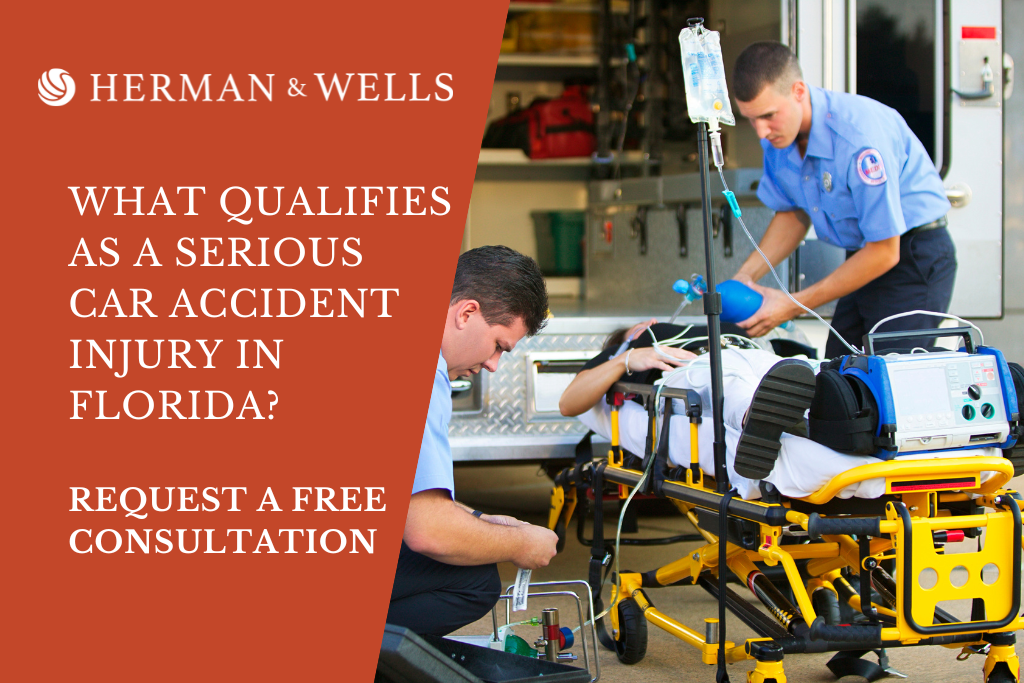Many vehicle accident claims in Florida are resolved by a no-fault system, one of the few no-fault systems in the US. It is an accepted principle that all drivers purchase insurance that will cover their own damages if they are involved in an accident, regardless of fault. There are a few notable exceptions, however. When you’ve been injured in a Florida car accident, you should know about the serious injury threshold. If you are unfamiliar with this aspect of Florida law, continue reading as it could be crucial information if you ever find yourself in a situation where you need to hire a personal injury attorney following a serious car accident.

The Cliff Notes: Key Takeaways From This Post
- 1Car accidents can result in a range of injuries, from minor to life-threatening. Injury severity can affect compensation and treatment needed.
- 2Common serious injuries linked to accidents include Traumatic Brain Injuries, Serious Extremity Injuries (Limb Loss or Amputation), Serious Spinal Cord Injuries (Paralysis), Chest Injuries, Cuts and Scrapes, Fractured Bones, and Soft Tissue Injuries.
- 3Factors that can lead to more severe car accident injuries include: wearing seat belts, the direction of impact, speed of collision, airbag deployment.
- 4Florida has a tort threshold for personal injury victims which establishes non-economic damages like pain and suffering or mental anguish for those who meet the serious injury thresholds like substantial disruption of central body functions and disability for 90 days or more.
- 5When injured in a car accident in Florida, victims should save all related documents including medical records and police reports to ensure proper compensation with the help of an experienced personal injury lawyer.
Impact vs Penetrating Car Accident Injuries
A car accident can result in almost any kind of injury, ranging from minor to catastrophic to fatal. Generally speaking, impact injuries and penetrating injuries can be classified. Penetrating injuries result from an object entering a victim’s body, while impact injuries happen when the victim strikes part of the car. Depending on the severity of the injury, it might heal on its own or after a moderate course of treatment, but it might need costly medical procedures or may persist indefinitely. A victim’s compensation may be affected by this.
Types of Serious Injuries Commonly Linked to Car Accidents in Florida
Traumatic Brain Injuries
Often, traumatic brain injuries occur due to car accidents, which cause brain damage through blows to the head or piercing injuries to the brain. Victims of high-speed collisions may strike their heads against steering wheels, windshields, or side windows. A sudden jolt to the head can lead to a closed head injury such as a concussion, as well as possibly cause more permanent forms of damage to the brain. Every year, TBI causes the deaths of 50,000 people and causes long-term disability for 80,000-90,000 more.
Serious Extremity Injuries (Limb Loss Or Amputation)
A sudden impact may cause a leg to strike the dashboard, the front seats, or a door if there is little legroom in a car. Accidents like these can lead to broken bones and shattered joints. It is possible to throw a victim’s arm or shoulder against a door, with similar results. The amputation of a limb may be necessary in extreme cases. An amputation is the loss of a limb (leg, arm, hand, finger, toe, or amputation of a leg) during a vehicle accident and involves removing the injured limb or digit. Despite being relatively rare, accidents lead to amputations on a regular basis. Accidents cause significant damage. In the event of a collision, all vehicles are composed of glass and sharp metal, so body parts can easily be cut or amputated.
Serious Spinal Cord Injuries (Paralysis)
As part of our central nervous system, our spinal cords collaborate with our brains. We can think of the brain as the command center of the body. In addition to transmitting signals to the body, the spinal cord also allows the brain to transmit signals back to the body. Maintaining spinal cord health is crucial for cognitive and physical functioning. In a car accident, the spine is at risk of injury in multiple areas. A number of factors can negatively impact the vertebrae, ligaments, and discs of the spinal column. Damage to the spine can cause the victim’s strength and the ability to detect sensation to be permanently altered. An injury to the spinal cord is graded according to its impact on the victim. Injuries to the spinal cord can be categorized into various levels of severity. A complete spinal cord injury occurs when the victim is completely unable to control their physical movement below the site of injury. The following can happen as a result of a spinal cord injury:
- Loss of mobility;
- Muscle spasms;
- Loss or weakening of sensation;
- Difficulty breathing;
- Sexual dysfunction;
- Paralysis; and
- Death
Chest Injuries
A driver or front-seat passenger’s chest can be damaged during an accident if it strikes the steering wheel, the dashboard, or another internal area of the vehicle. This may result in broken ribs as well. In addition, drivers or passengers may be abruptly pushed against their seatbelt or shoulder harness, which can lead to severe contusions.
Common Car Accident Injuries That Are Less Serious
In addition to the severity of an injury determining how life-altering an accident experience will be, it is important not to disregard injuries that may appear less severe. Despite the fact that the following injuries are unlikely to result in death or severe harm, they may still have lasting effects. Here are a few examples of serious injuries caused by car accidents:
Whiplash
The term whiplash refers to injuries to the neck. Head movements that occur too rapidly or violently cause this condition. Whiplash victims often feel their necks crack like a whip when they suffer injuries. Most people recover quickly after suffering whiplash. Some people may suffer from chronic neck pain for the rest of their lives.
Cuts And Scrapes
Lacerations that are large can be fatal. The majority of accident victims, however, walk away from crashes with only minor injuries. You should ensure that you take proper care of these injuries and seek medical attention if necessary. In the event that you suffer from these injuries, you should seek medical attention. A wound left untreated during the healing process may become infected or more severe.
Fractured Bones
Although some bone fractures can be life-changing, most of them are considered minor injuries. In comparison to more catastrophic fractures, minor fractures can still be extremely painful. The treatment for broken bones that are not immediately visible or do not break the skin is often much easier. One of the most common car accident injuries is a leg fracture.
Soft-Tissue Injuries
It is purposefully vague to use the term “soft tissue injuries.” Injuries to soft tissues during the course of an accident can affect any muscle, ligament, or tendon. One type of soft tissue injury is whiplash. Another common soft tissue injury is ACL tears.
Risk Factors Linked to More Severe Car Accident Injuries in Florida
A number of factors can be used to evaluate the type and severity of injuries sustained by drivers and passengers in a crash, including:
- During the car accident, were the individuals wearing their seat belts?
- How did the collision or impact occur?
- The occupants of the vehicle faced which direction at the time of impact (i.e., straight ahead or turned in a certain direction)?
- Was it a low-speed or high-speed crash?
- Did the airbags in the vehicle involved in the accident deploy?
The Florida Serious Injury (Tort) Threshold
No-fault Florida law exempts serious injuries from the threshold. Under Florida law, victims of car accidents who meet the serious injury threshold can receive pain and suffering damages. Through their PIP no-fault insurance policies, car accident victims are typically limited to collecting economic damages. A victim who meets the serious injury threshold standards can, however, pursue a tort claim against the responsible driver outside of the no-fault system. In Florida, the tort threshold stipulates that personal injury victims be entitled to non-economic damages, such as pain and suffering or mental anguish.
What is considered a serious injury in a car accident? In Florida, the injury must interfere with your day-to-day activities to meet the severe injury threshold. If you lose a central body function, experience disfigurement or scarring, or are totally or partially disabled for 90 days or more, you may qualify. Additionally, it is possible to pursue claims under this statute in Florida for injuries that result in death. Potential plaintiffs must also sustain injuries that were directly caused by the at-fault party’s actions and must result from the accident. The Florida tort threshold does not apply to economic damages, including actual financial losses incurred as a direct result of the accident. Two examples of economic damages are medical bills and vehicle replacement costs.
How Does Florida’s Serious Injury Threshold Work?
In Florida, you usually rely on your own insurance company to pay for your damages after a car accident. In order for your PIP benefits to kick in, you must seek medical attention as soon as possible after the crash. PIP insurance covers your damages. Up to the limits of your policy, your insurance company will pay 80 percent of your medical expenses, and 60 percent of your lost wages. If you wish to extend your PIP coverage, you may purchase more substantial amounts. Under Florida law, you must have at least $10,000 in PIP benefits. Florida law 627.737 does not apply if your injuries qualify for one of the thresholds. Traditional tort law and negligence laws will apply. You can sue the party responsible for your injuries. According to Florida law 627.737, non-economic damages can be claimed if you meet certain standards. Economic damages and lost wages aren’t the only forms of compensation. Instead, you can file a lawsuit to be fully compensated for all of your damages under Florida tort law, including pain and suffering.

Evidence Required to Meet the Serious Injury Threshold in a No-Fault State
You may need to provide evidence of the extent of your injuries in order to prove that you meet the Florida tort threshold and qualify for non-economic damages in your personal injury case. Examples include:
- Records of medical treatment
- A doctor’s statement
- And possibly more
After an accident, your medical professional can ensure there are no gaps in your treatment. Keeping regular appointments with your doctor will allow you to track the progress of your injuries and document how they are affecting your life. Make sure you follow up with any recommendations your doctor gives you and keep your records in a secure place.
If you are involved in a personal injury accident, it is recommended that you save all documentation related to the incident in case the evidence is needed in court. These documents include:
- Any receipts for services related to the accident
- Bills related to medical care
- Witness contact information
- Photographs of the accident scene
You should keep copies of all correspondence with your employers to prove how many days of work you missed due to your injury. It may also be possible for the other party to contact you, depending on what kind of accident occurred. Typically, this will be by letter, email, or phone call from their insurance company, as well as yours. Maintain these records.
Benefits Available for Victims With a Serious Car Accident Injury in Florida
When serious injuries result in disability, it is possible to file additional claims for benefits with various agencies, such as the Social Security Administration. When you file for disability benefits after a personal injury accident, those records may assist in proving that you sustained a permanent injury. Likewise, if you are unable to work due to your injuries and file for Unemployment, these records may support your claim.
Injured in a Florida Car Accident? Contact Our Experienced Personal Injury Lawyers
If you or someone you know has been recently injured in a Florida car accident, contact Herman & Wells. Our personal injury lawyers in Pinellas have handled a variety of personal injury cases, including car accidents, motorcycle accidents, tractor-trailer accidents, and wrongful death cases.
Contact us at (727) 821-3195 for a free legal consultation.





